East German Tanks & AFVs of the Cold War
 About 8,000 armoured vehicles 1947-1990.
About 8,000 armoured vehicles 1947-1990.
Formation of the East German Army
The Nationale Volksarmee (NVA) was formed on 1 March 1956. Before it, Germany of course had no army as per the armistic conditions and soviet occupation. Instead, a system was set in place, the "Kasernierte Volkspolizei" or literraly the "Barracked People's Police", which was a military police (or gendarmerie) under supervision, equipment, methods and training (even uniforms) of the Soviet Army. It was a unique case among Warsaw Pact militaries opposing NATO, since it was the only "police force" instead of a proper army.The German Democratic Republic's National People's Army was created six months after the Bundeswehr) and the delay was also a reason of years of preparation seeing former Wehrmacht officers and communist veterans of the Spanish Civil War organizing and train at first paramilitary units (The People's Police), but the use of former German Generals, most of those captured at Stalingrad, antinazi or for one of them, Müller already a staunch communist, was not easy for Soviet authorities. The new government suggested to ressurrect the old tradtions of the German army and specific uniform, march and parade, yet its doctrine and structure showed still a strong influence of Soviet Armed Forces, and of course its equipment.
The army was gradually allowed to mount armoured divisions, all equipped with Soviet tanks, APCs and later IFVs as well as specialized vehicles. In time however, given the production quality in Germany, several vehicles were gradually built in germany, although faithful copies of Soviet models. Like the Polish and Czech-built materials, they had excellent reputation and quickly found clients in 1990.
In 1956, 27% of NVA's officer corps came from the former Wehrmacht and at the top, 61 out of 82 high command positions were also taken by ex-Wehrmacht officers and their military knowledge and combat experience proved invaluable in shaping the NVA as the most impressive force, as seen by NATO. This was only transitional as by the 1960s, most wartime veterans retired, more so than in the West, where the Bundeswehr counted in crushing majority Wehrmacht veterans, including lower ranks later promoted.
In case of war in the 1960s, none knew how these former Wehrmacht men would had done, facing each other through binocular and on the battlefield. Until 1960, the NVA relied on volunteer whereas West Germany re-introduced universal military service in 1956. Conscription was ordered in turn in 1962. In 1987, all three branches had 156,000 men under arms and 175,300 personnel total, and during the cold war, about 2.5 million men were in the military.

"Prussian" in surface, but strong ideology
NATO officers would later rate the NVA as the best military in the Warsaw Pact (for discipline, training, and officer leadership), but it went a long way. The NVA oly active deployment was a participation in the invasion of Czechoslovakia in 1968, but only through military advisors. This force was also responsible of the Berlin wall strict enforcement control, resulting in many deaths. The NVA was eventually dissolved on 2 October 1990 before German reunification. Both the facilities and equipment were handed over to the Bundeswehr, absorbed most of its personnel but get rid of officiers and resold or scrapped its equipments for the sake of standardization. However despite its "germanization", the NVA was under strict ideological supervision by Moskow, through notably the SED (local communist party) which appointed its members at the top.The NVA was officially missioned to "protect peace and secure the achievements of socialism, by maintaining a convincing deterrent to imperialist aggression". Its flag-written motto was "For the Protection of the Workers and Farmers' Power". It was quite unique in its unlikely marriage of old prussian traditions and communist ideology. From a Leninist perspective, it was even a symbol of Soviet-East German solidarity, the model communist institution, strong in ideologiy, hierarchical and disciplined. The Friedrich Engels Military Academy formed all the cadree of the army, after Karl Marx's co-author. It became the highest award after General Gerhard von Scharnhorst's medal.

Czech-built T-55A at panzermuseum Munster
Organization
The NVA comprised four branches:- The Landstreitkräfte (Ground Forces)
- The Volksmarine (Navy)
- The Luftstreitkräfte (Air Force)
- The Grenztruppen (Border Troops).
They were at first trained in defense, to parry a NATO offensive in the fulda gap notably and known ways, but from the 1980s, it was tactically train to integrate with the Soviet armoured divisions for offensive roles. Outside these, the German infantry was motorized integrated into the 1st, 4th, 6th, 8th, 10th, 11th, 17th, 19 and 20th Motor Rifle Division, based in Potsdam-Eiche, Erfurt, Königswartha, Schwerin, Ronneburg, Halle, Petersroda, Wulkow and Bredenfelde, using the great variety of APCs and trucks.
Reforms
From 1962, conscription became mandatory for all GDR males aged between 18 and 60 requiring an 18-month service, and it was the only Warsaw Pact military to offer non-combat roles to conscientious objectors, known as "construction soldiers" (Bausoldat). At that time, 85,000 soldiers were enlisted and it climbed to 127,000 by 1967. It grew slowly but steadily until reaching the 1987 peak. All this time it was a mix between 50% career soldiers (and officers) and short-term conscripts. Since the NVA was popular (it never took part of example in crowd control operations), it never lacked recruits, in an economocal situation which became dire in the 1980s.NVA leaders came predominantly from working-class backgrounds, with a weakening old artistocratic Prussian elite. By 1970 all the former Wehrmacht top officers had now retired. These were Generalmajor Wilhelm Adam, Otto Korfes, Vincenz Müller, Rudolf Bamler, Bernhard Bechler, Otto Korfes, Arno von Lenski, and Hans Wulz.
The best warsaw pact army ?

T-55AM2B at the Panzermuseum Munster
Industrial basis

Luna-M Frog 7 ZIL TEL
In 1990, when reunification was started, the Bundewehr's federal Materiel Depot Service Gesellschaft (MDSG) had to handling some 2,761 tanks (T-54/55 and T-72s of all late variants), IFVs like the BMP-1, BMP-2, BTR-152, 60, 70 and BTR-80, BRDM1/2, but also Polish-Czech vehicles such as the OT-64 and Hungarian Fug armored car. The motorized infantry and support counted on 133,900 wheeled vehicles, Soviet for a majority. Also it was left with 2,199 artillery pieces. Only the Soviet army had access to (and repatriated) tactical missiles and their TEL vehicles. However SAM batteries in some case also fell under German control.
IN reality only a few armored vehicles were built in East Germany compared to Poland or Czechoslovakia. Some local variants and denominations were made however. The East Germans for example used the Czech-produced tanks and AFVs whenever possible, because they were believed of better quality and Soviet doctrine. However, East Germany created many specialized vehicles based on Polish or Czech-built tanks.
The T-54/55 in NVA service
- T-54Z/AZ/AMZ (Z for Zusatzausrüstung - additional equipment): Modernized as the Soviet T-54AM.
- T-54T (Panzerzugmaschine ohne Bergesatz): recovery and welding equipment, 10 made (NATO T-54(A))
- T-54TB (Panzerzugmaschine mit Bergesatz): T-54T with 140-t winch. 10 made (NATO T-54(B))
- T-55AM2B: with the "Czech" binn on left-hand-side of turret.
- T-55 NAL NRD: unfinished local modenrization, 1989-1990
- T-55T: VT-55A with push bar and splashboard, or with towing unit on the glacis and flexible 'eye' (NATO T-55T)
- Minenräumfahrzeug: East German KMT-5 or KMT-6 M2, EMT-5 electronic mine clearer WLWD lane clearer
- T-54 M1975/1 Prototype roller/flail mine clearing vehicle.
- T-54 M1975/2 Flail variant of the above.
- Kranpanzer T-55T: 119 Czech JVBT-55A (1968 and 1979).
- Brückenlegegerät BLG-60, 1965 scissors-type bridge layer. 200 built by STAG Genthin, SKET Magdeburg.
- BLG-60 trainer bridgelayer version
- BLG-60M (1973) Improved model with 2 bridges together, 36 m.
- BLG-60M2 (1981): 30 BLG-60Ms widened by 20 cm, 3 bridges, 52 m now.
The Kampfpanzer T-72 in NVA service
- Kampfpanzer T 72M: Upgraded by RWN in 1986, rubber side skirts, smoke grenade launchers "Tucha", addon 16 mm steel glacis plate.
- Kampfpanzer T 72M Übergangsversion (1986): 23 late-prod. Polish T-72Ms with additional hull armour.
- Führungspanzer T 72(K/K1). Designation for command tanks.
- Kampfpanzer T 72TK: VT-72B (BRAM-72B) planned for 1990*
- Brückenlegepanzer 72 (1987) bridgelayer tank project canceled.
- Fahrausbildungspanzer (FAB) 172M/FAP 172U, driver training vehicle, three made with the cancelled BLP 72.
East German BMP-1
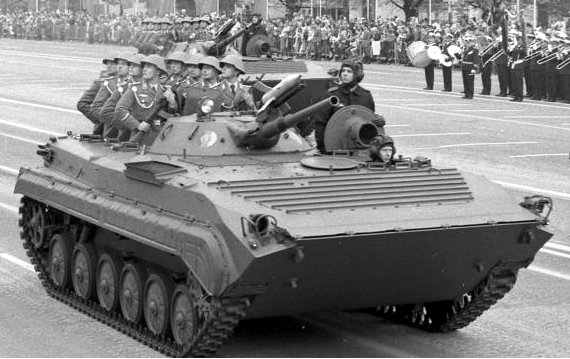
No specialized version was made. The West-German Bundeswehr obtained 851 vehicles after 1990 (mainly BMP-1P). They were brought to NATO standards, known as the BMP-1A1 Ost. 764 were extant (remainder sold) in 1994, and only 450 in 1996. The remainder were scrapped or sold, including 110 previously to Finland unmodified. 501 BMP-1A1 Ost were sold to Greece in 1993–1994, 350 to Sweden also.
East German BMP-2
East Germany obtained 24 of these, delivered in 1986-1987 possibly from Czechoslovakia. They were passed on to the Bundewehr but not standardized and sold or given to museums.Schützenpanzerwagen 60
- SPW-60P: BTR-60P
- SPW-60PA: BTR-60PA
- SPW-60PA(S): staff vehicle.
- SPW-60PB: BTR-60PB
- SPW-60PB(ABS) (Artillerie-Beobachtungsstelle) artillery forward observer/
- SPW-60PB(BBS) (Batterie-Beobachtungsstelle) AA command vehicle**
- SPW-60PB(S) SPW-60PB Command vehicle
- NZ(B) MSR/PR: (Nachrichtenzentrale) signals vehicle for rifle & tank regiments***
- LBGS(B) (Leitungsbaugerätesatz) telephone cable layer
- R-137B signals vehicle****
- R-140BM signals vehicle with R-140M SW radio set*****
- R-409BM radio-relay station ******
- R-145BM/AKL1 signals vehicle with additional R-870M set.
- R-145BM/AKL2 Signals vehicle with addon R-809M2 set.
- R-145BM/L1 Signals vehicle.
- R-145BM/L2I same with R-111, R-123MT, R-130M, R-809M2, R-859D R-863
- P-238-41BT: Switchboard vehicles SAS and Chiffrier Services
**Similar to the SPW-60PB but it has two whip antennas on the rear hull.
***It is equipped with the R-123M, R-123MT and R-405 radio sets, the AB-2-0 generator mounted behind the turret and the F-1301 electronic telegraph. Turret has been blanked-off.
****Differs from the Soviet type, local components like the FF63M field telephone set.
*****Has two rear movable whip antennas, 10 m high telescopic mast, AB-4-T/230-M1 generator, local EKD 315 SW receiver.
****** Has two R-409MA semi-sets and receivers R-326, R-123MT, P-303-OB AB-2-0/230-M1 generator.
Schützenpanzerwagen 70
1,316 of these BTR-70, locally called Schützenpanzerwagen 70 were delivered 1980-1990 from Romania.- SPW 70(S): Staff vehicle*
- SPW 70(SL): Forward air control vehicle**
- SPW 70(Ch): NBC reconnaissance vehicle***
**R-809M2 radio and fitted with four whip antennas.
***Has detection and marking systems, but remained as a Prototype.
Schützenpanzerwagen 50
- SPW 50PK(Akl): Local Recce version
- SPW 50PK(D/B): Bergefahrzeug*
- SPW 50PK(BBS) Batteriebeobachtungsstelle – AA units Observation vehicle
- SPW 50PK(KM) (Kernmine) Fitted with combat engineers PGS-5 (Pioniergerätesatz)
- SPW 50PK(LA): Luftabwehr Command vehicle for air defense units.
- SPW 50PK(MRF): Minenräumfahrzeug, mine-clearing vehicle**
- SPW 50PK(Pi) Command vehicle for combat engineers (Pioniere)
- SPW 50PK(S) Command and staff vehicle.
- SPW 50PK(UF) Unterwasserfahrt for Pioniergerätesatz, river crossings.
- SPW 50PU(A) Local artillery division command vehicle
**Equipped with two containers for mine-clearing charges WLWD of Polish design. The containers were loaded onto the roof of the troop compartment via two ramps, welded on the engine deck.
Operations
The NVA never took part in combat operations, only sending advisors during the Prague Spring of 1968, so a support role. The 7th Panzer Division and the 11th Motorised Infantry Division were nevertheless deployed to support the 20th Guards Army and 1st Guards Tank Army respectively. But since WW2 was not forgotten, this created a stir and soon, they were "kept out of sight in the Bohemian forests", only travelled by night, soon withdrawn and never called back again.Reputed NVA officers also served as combat advisers in Africa, taking part in some of the bloodiest civil wars here. Among the first, were NVA advisors in Congo, in 1973. Others intervened in the 1980s in Algeria, Angola, Ethiopia, Guinea, Iraq, Libya, Mozambique, South Yemen, and Syria.
In the 1970s the High command of the GSFG or "Group of Soviet Forces in German" asked the NVA to capture West Berlin, a plan called "Operation Centre". Some 32,000 troops were to be mobilized (two divisions), escorted and covered by the GSFG's Soviet 6th Separate Guards Motor Rifle Brigade. The plan updated and practiced virtally every year, but at some point substituted to just containing Berlin. In the autumn 1981 however, the NVA was placed on high alert during the Polish troubles, ready to intervene in support of Soviet Forces. It was ended by the declaration of martial law in Poland on 13 December 1981 under Marshal Jaruleswki.
Other high alert, combat readiness state included the construction of the Berlin Wall in 1961. The next year also, the Cuban Missile Crisis of 1962 saw all units on the war footing and prepared. The last mass mobilization and patrols was in late 1989, during the protests in East Germany preceding the fall of the wall.
Read More
https://en.wikipedia.org/wiki/Hungarian_Ground_Forceshttps://en.wikipedia.org/wiki/National_People%27s_Army
https://en.wikipedia.org/wiki/D-442_FUG
https://partisan1943.tumblr.com/post/159177553660/east-german-2s1-gvozdika-self-propelled-artillery
https://btr40.tripod.com/mt-lb/id13.html
https://en.wikipedia.org/wiki/Land_Forces_of_the_National_People%27s_Army
Theodor Hoffmann: "Das letzte Kommando", Mittler, 1993, ISBN 3-8132-0420-0, p. 320
Deutsches Institut für Militärgeschichte, Militärgeschichte, Vol. XI, Deutscher Militärverlag. 1972.
Rüdiger Wenzke:Die Streitkräfte der DDR und Polens in der Operationsplanung des Warschauer Paktes, Militärgeschichtliches Forschungsamt, 2010
Shawn Bohannon Mobilmachungsdivisionen / Reservedivisionen, Axis History Forum
Steven J. Zaloga and James Loop, Soviet Bloc Elite Forces, Osprey Publishing, 1998, had the initial report of the battalion, more recent critical commentary is at Tanknet > NVA Special Units
Dale Roy Herspring, Requiem for an army: the demise of the East German military, Rowman & Littlefield Publishers, 1998
Jörg Schönbohm, Two armies and one fatherland: the end of the Nationale Volksarmee, Berghahn Books, 1996
Zilian, Jr., Frederick. 'From Confrontation to Cooperation: The Takeover of the National People's (East German) Army by the Bundeswehr,' Praeger, Westport, Conn., 1999
Videos
East German Tanks nomenclature
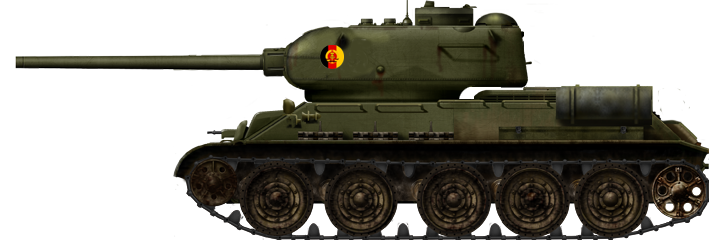
East German T-34/85

East German T-54A

East German T-55A in 1965

East German T-55AM2B Kladivo in 1989

T-72A

Another T-72M1

Camouflaged T72M1 in the 1980s
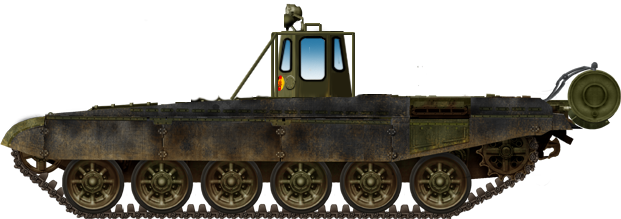
T-72 Fahrschulepanzer
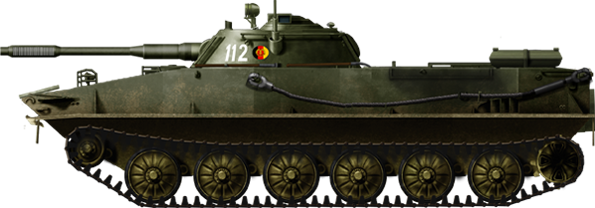
East German PT-76 model 1951

BMP-1 in winter camouflage
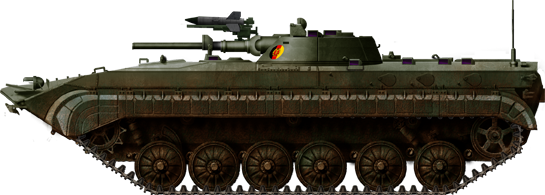
East German BMP-1

BMP-1A1 Ost
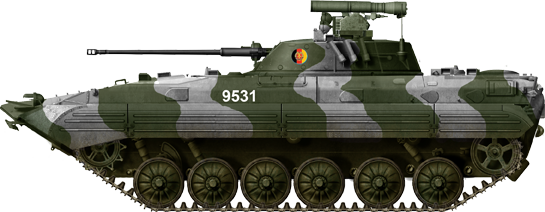
East German BMP-2
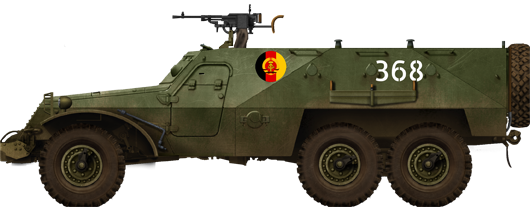
BTR-152. Only the SPW-152 armored ambulance and SPW-152U command version were local variants
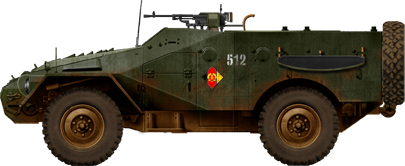
Schützepanzerwagen 40. The SPW-40A was the local BTR-40A and SPW-40Ch local BTR-40Kh. East Germany produced the SPW-40 Jagdpanzer, armed with elevating ATGM launcher (9M14 Malyutka), armoured roof, cut down troop compartment, no firing ports.

BTR-50 PK
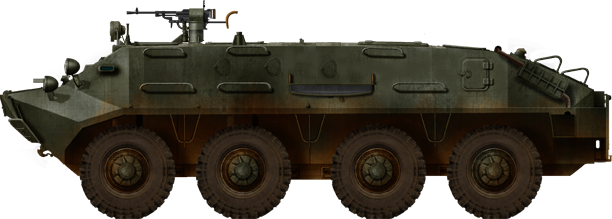
BMP-60
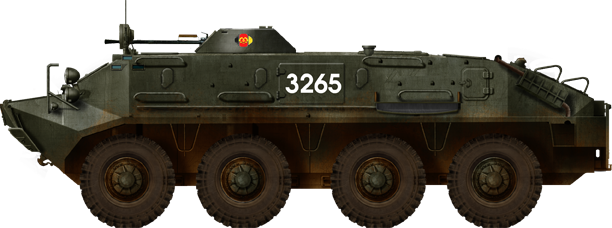
Schutzenpanzerwagen 60PB
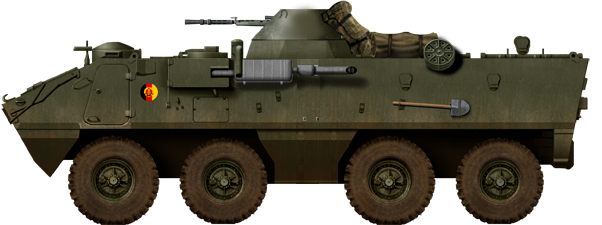
Schutzenpanzerwagen OT-64 Skot

Schutzenpanzerwagen-70

Schutzenpanzerwagen-70 camouflaged, 1980s
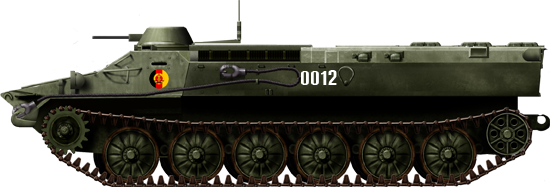
East German MT-LB
East German Missiles TEL

ZIL 135 (9K52 Luna-M)

MAZ-543 (R-17 Elbrus)
BAZ-5921 (OTR-21 Tochka)
9P71 TEL (OTR-23 Oka)
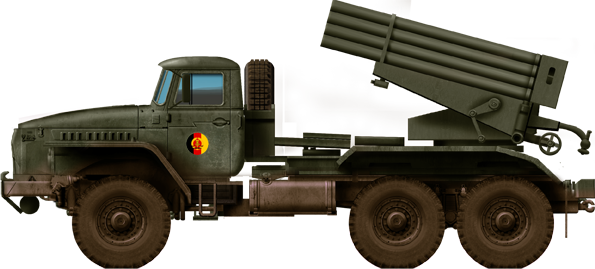
BM-21 Grad
RM-70 multiple rocket launcher
East German Mobile artillery
Towed artillery: 100 mm anti-tank gun T-12, 122 mm howitzer 2A18 (D-30), 152 mm towed gun-howitzer M1955 (D-20), 130 mm towed field gun M1954 (M-46), 85 mm divisional gun D-44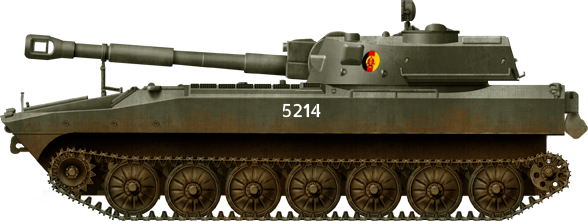
2S1 Gvozdika
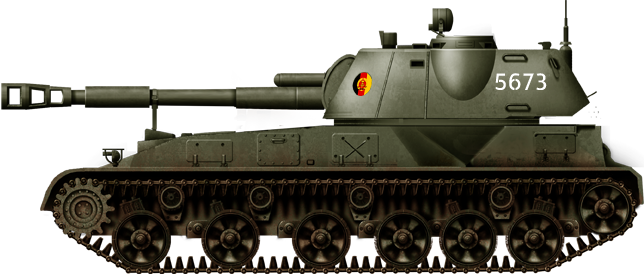
2S3 Akatsiya
East German SPAAG
Ground-based Mobile missile: 2K11 Krug, 2K12 KubTowed anti-aircraft gun : ZPU, ZU-23-2, AZP S-60
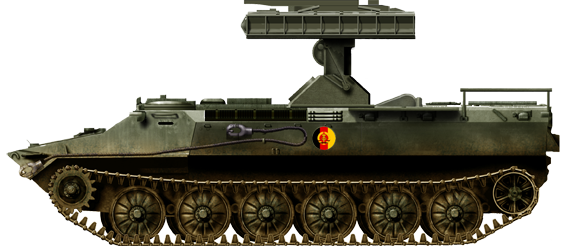
9K35 Strela-10
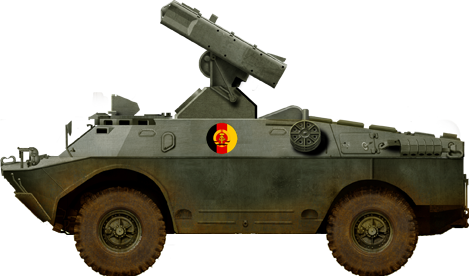
9K31 Strela-10
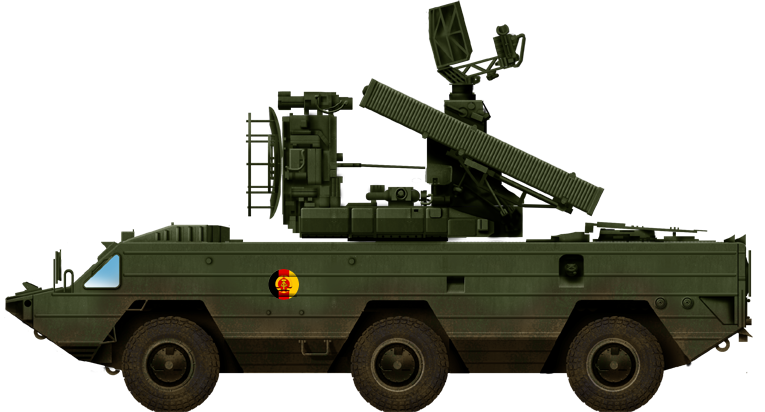
9K33 Osa
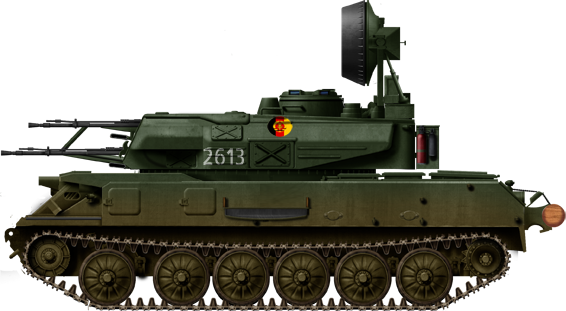
ZSU-23-4 Shilka
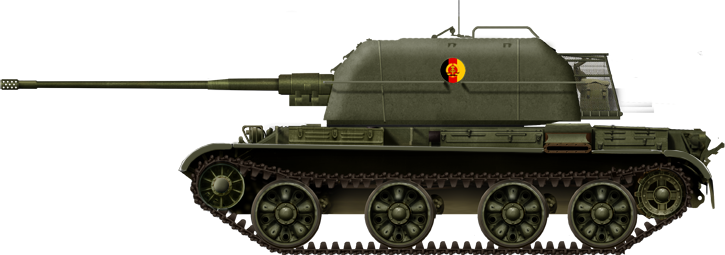
ZSU-57-2

Cold War Tanks


































Cold war tanks posters

Cold War Main Battle Tanks

Cold War Soviet Army
Museums, Movies, Books & Games
The Tanks and Armor in pop culture
Tanks and armored vehicles in general are only really grasped when seen first person: The mass, the scale, it's all there. Explore also the way tanks were covered in the movie industry, in books and in video games.Movies:
Best tanks movie on warhistoryonline.com
On imdb.com
On bestsimilar.com/
miltours.com
liveabout.com/
watchmojo.com
Video Games:
pcgamesn.com
historyhit.com
levvvel.com
vg247.com/best-tank-games
mmobomb.com/
alienwarearena.com
